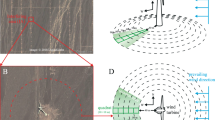Abstract
The effects of wind turbines and other physical landscape elements on field utilization by wintering pink-footed geese (Anser brachyrhynchus) were studied in a Danish farmland landscape. Within the study area geese were feeding on pastures, which together with cereals were the main crop types. Apart from wind turbines a variety of potentially disturbing landscape elements was present, e.g., high-power lines, windbreaks, roads and settlements. Patterns of field use were assessed by measuring goose dropping densities along transects perpendicular to wind farms (with turbines in clusters and in lines) and other landscape elements. Local effects were expressed in terms of `avoidance distance', i.e., the distance from a given landscape element to the point at which 50% of maximal dropping density was reached. The spatial distribution of landscape elements within an eight km radius from the goose roost was determined from aerial photographs. The area occupied by various elements, together with the adjacent zones which were not available to geese due to their associated avoidance distances, were quantified using Geographic Information System (GIS).
The avoidance distance of wind farms with turbines in lines and in clusters were ca 100 m and ca 200 m, respectively. Geese did not enter the area between turbines within the cluster. At the landscape level, the combined effect of physical elements other than wind turbines caused an effective loss of 68% of the total field area (40 km2). Wind turbines caused an additional loss of 4% of the field area. However, of the remaining area available to geese (13 km2), wind turbines caused a loss of 13% of the total area. The habitat loss per turbine was higher for the wind farm with turbines arranged in a large cluster than for wind farms with turbines in small clusters or lines. This difference was mainly due to the fact that wind farms in small clusters or with a linear layout were generally placed close to roads or other elements with existing associated avoidance zones, whereas the large cluster was placed in the open farmland area. The avoidance zones associated with physical elements in the landscape do not take into account possible synergistic effects and, hence, actual field areas affected are likely to be minimum estimates. Implications of these findings for planning of wind farms in areas of conservation interest to geese are discussed.
Similar content being viewed by others
References
Anonymous 1996. EF-fuglebeskyttelsesområder og Ramsarområder. Ministry of Environment and Energy, National Forest and Nature Agency, Denmark (in Danish; English summary).
Dirksen, S. J., Spaans, A. L. and Van derWinden, J. 1998. Nocturnal collision risks of birds with wind turbines in tidal and semioffshore areas. In Wind Energy and Landscape. Proceedings of the International Workshop on Wind Energy and Landscape. pp. 99–108. Edited by Ratto, C. F. and Solari, G. Balkema, Rotterdam, The Netherlands.
Fox, A. D. and Madsen, J. 1997. Behavioural and distributional effects of hunting disturbance on waterbirds in Europe: implications for refuge design. J Appl Ecol 34: 1–13.
Guillemette, M., Larsen, J. K. and Clausager, I. 1998. Impact assessment of an off-shore wind park on sea ducks. 61 pp. NERI Technical Report No. 227. National Environmental Research Institute, Denmark.
Guillemette, M., Larsen, J. K. and Clausager, I. 1999. Assessing the impact of the Tunø Knob wind park on sea ducks: the influence of food resources. NERI Technical Report No. 263. National Environmental Research Institute, Denmark. 21 pp.
Kruckenberg, H. and Jaene, J. 1999. Zum einfluss eines Windparks auf die Verteilung weidender Blässgänze im Rheiderland (Landkreis Leer, Niedersachsen). Natur und Landschaft 74(10): 420–427.
Madsen, J. 1985a. Relations between change in spring habitat selection and daily energetics of pink-footed geese Anser brachyrhynchus. Ornis Scand 16: 222–228.
Madsen, J. 1985b. Impact of disturbance on field utilization of pinkfooted geese in West Jutland, Denmark. Biol Conserv 33: 53–63.
Madsen, J. 1996. Exposure of spring-staging pink-footed geese Anser brachyrhynchus to pesticide-treated seed. Wildl. Biol. 2: 1–9.
Madsen, J. 1998. Pink-footed geese invade Vejlerne. In: Vejlernes natur. Status over reservatets mangfoldighed–1998. pp. 163–169. Edited by P. Hald-Mortensen. Aage V. Jensens Fonde, Denmark (in Danish; English summary).
Madsen, J., Kuijken, E., Meire, P., Cottaar, F., Haitjema, T., Nicolaisen, P. I., Bønes, T. and Mehlum, F. 1999. Pink-footed Goose Anser brachyrhynchus: Svalbard. In: Goose Populations of the Western Palearctic. A review of status and distribution. pp. 82–93. Edited by J. Madsen, G. Cracknell and A. D. Fox. Wetlands International Publ. No. 48. Wetlands International, Wageningen, The Netherlands. National Environmental Research Institute, Rönde, Denmark, 344 pp.
Percival, S. M. 1999. Birds and wind turbines: managing potential planning issues. In Wind Energy Conversion 1998. Proceedings of 20th British Wind Energy Association Conference. pp. 345-350. Edited by Anderson, M. Mechanical Engineering Publications Limited, London, UK.
Winkelman, J. E. 1989. Vogels en het windpark nabij Urk (NOP): aanvaringsslachtoffers en verstoring van pleisterende eenden ganzen en zwanen. RIN-report 89/15. Rijksinstituut voor Natuurbeheer, Arnhem, The Netherlands (in Dutch; English summary).
Winkelman, J. E. 1992. De invloed van de Sep-proefewindcentrale te Oosterbierum (Fr.) op vogels. 4. Verstoring. RIN-report 92/5. DLO-Instituut voor Bosen Natuuronderzoek, Arnhem, The Netherlands (in Dutch; English summary).
Author information
Authors and Affiliations
Rights and permissions
About this article
Cite this article
Larsen, J.K., Madsen, J. Effects of wind turbines and other physical elements on field utilization by pink-footed geese (Anser brachyrhynchus): A landscape perspective. Landscape Ecology 15, 755–764 (2000). https://doi.org/10.1023/A:1008127702944
Issue Date:
DOI: https://doi.org/10.1023/A:1008127702944




